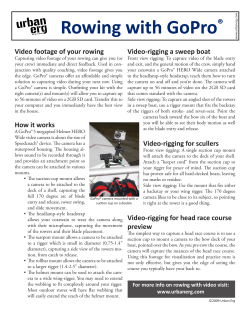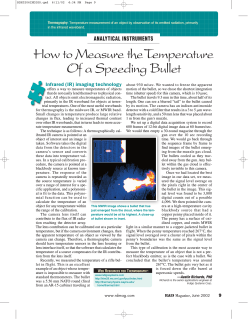
Document 223035
Another in the series of OPC (Omagh Photographic Club) PowerPoint presentations aiming to give advice/tips etc. for anyone – beginner or seasoned photographer. The presentations are related to the themes of our fortnightly competitions (open to everyone) It is hoped to encourage more members to submit competition entries. For the more experienced much of what follows may be ‘old hat’. However, newer members may be keen to pick up tips and ideas, and in the multifaceted world of contemporary photography it is hoped that the odd refresher won’t do any of us harm! and * No need to take notes! Just access these tips by visiting our website at www.omaghphotoclub.co.uk If you’re puzzled about any aspect of the presentation, please ask for clarification. Any question welcome. Feel free to ask at any time. Someone in ‘OPC’ should be able to help! ? Tonight – 11 Panorama Photography Tips For reference thanks to www.digital-photography-school.com & others With film loading cameras, creating a panoramic photograph meant either buying a particular, expensive camera or hours in the darkroom stitching images together by overlapping exposures onto the finished photo paper. Panoramic photos were the realm of the professional with time and funds to create super wide angle shots. Now, in the digital age, it’s not only simple to create panoramic images on our home computers, it’s become increasingly easier thanks to advances in software. There are still some general guidelines to follow to help us increase our odds of producing great photos, because remember, you can’t fix everything in a computer – it’s best to get as much right in the camera as possible! 1. Use your camera’s panorama mode if it has one. Most compact point and shoot cameras beyond the most basic model come with a little used mode for creating panoramic images: e.g. This mode serves two functions: First: it’ll use the display on the camera to show your last picture taken and then a live view of the next picture. This is done to help you line up your images and overlap them. Second: it also adjusts the camera to not change exposure settings in between shots as it normally would. This helps create even lighting through all the pictures, making stitching in the computer a lot easier (although a number of modern programmes will also level exposure fairly well). 2. Overlap Amply Overlapping is one of the important areas in creating a panoramic image. Just one slip with not enough overlap can ruin an attempt at the grandest of wide angle shots. No one wants to see pictures of the Grand Canyon with a bar of white down the middle because of the failure to overlap properly. Some overlap by 30% each time sometimes more. Most people say 15% works just fine. e.g. This shows typical overlapping margins. Experiment with your particular camera to find the sweet spot of overlap. Increasing the amount of overlap helps reduce “flaring” that happens when the software is forced to use all of the image frame, including the corners which may show distortion depending on your lens selection. 3. Keep It On The Level Keeping your camera level becomes more important as you combine more images. If you’re shooting four or five images there isn’t much you need to worry about. But if it’s a monster 40 image shot, it becomes more and more important to keep things on the level. Think of it this way - your lens is a curved piece of glass. When held level, all parts of the scene in front of it come in and hit the sensor at roughly the same angle. But if you point that camera down, say 45 degrees you now have distant objects, like mountains in the background, coming in at a much sharper angle than foreground objects. For a single picture, this isn’t a problem, but for a panorama it creates a fan effect which is not so easily fixed in the computer. What this means is as you pan the camera left to right, the distant objects will fan out and may not have ample overlap. Further, they will be more distorted and curved because of the angle their light enters the camera. This is best shown in the example below, taken at Bryce Canyon, Utah. The DSLR was pointed down too far in order to catch more of the canyon. But what happened instead is the distant horizon became naturally distorted because a 16mm lens was used. This distortion was too much to overcome in the computer afterwards and the result - the choppy image you see here. The foreground detail lines up right, but not the distant horizon. 4. Choosing Your Metering Well If you are using a DSLR or other camera that doesn’t have the a Panorama Mode, you’ll want to set your metering mode to manual. Otherwise you could end up with an image like this. Can you see the difference in exposure in the skyline? The computer was able to adjust well enough to the foreground canyon, but failed to even out the sky all the way. Had the camera been set to manual, this would not happen. It’s also important to even out your metering, meaning scan the entire scene making note of the aperture and shutter speeds your camera is suggesting, then pick one pair of settings in the middle, or slightly darker to make sure any sky detail is preserved. With those shutter and aperture settings dialled in, it’s time to shoot away. 5. Check The Scene For Movement Movement in the scene can be a thief of what would otherwise be a grand shot. Sometimes the blur, or doubling up of people, cars, planes or other moving objects is acceptable. But too many blurry spots (caused when the computer finds parts of the overlapping sections where things don’t line up) can ruin the shot. It may mean you need to take the images very quickly. And sometimes, that movement is just unavoidable. 6. Be Careful with Super Wide Angle Lenses The lens used for this image was also too wide angled. If something closer to a 50mm lens had been used & multiple passes made at the scene, the distortion in the distance would have been lessened & perhaps the shot could have been salvaged. A great wide angle lens does not always produce great panoramic shots. Sometimes it’s better to let the stitching software do what it does best and make multiple passes of the same scene, with ample overlap, to create your masterpiece. 7. Look All Around and Up and Down With new software you are not limited to just a single pass from left to right to capture the wanted image, so don’t be afraid to make more than one pass. Start with the initial pass from left to right (or top to bottom) and then move up or down to grab more detail and make another pass. Remember the overlapping rule above and how it’ll now relate to not only the sides of the shot, but also the top and bottom overlaps. Keep it tight and your image can have the added quality of extra skyline or foreground features previously missed. 8. Don’t Forget Vertical Panoramas! Vertical shots are often overlooked. The same principles apply to verticals shots as do to horizontal images. It may help to turn the camera on its side or you may find keeping the camera in a horizontal orientation works. Experiment a little with buildings and waterfalls and then start looking for other verticals you can shoot. 9. Pseudo Panoramic Photography. There’s another way to achieve what is known as a pseudo panorama. This is achieved by simply cropping the top and bottom off of a wide angled shot turning it into a letterbox shape. When using this technique it is important to ensure that there is sufficient visual interest and sharpness in the detail left in the final image. 10. Other Stuff a) Digital camera. As panoramas are most easily done in software, and to save mucking around with a scanner, a digital camera makes life much easier. b) Tripod. Even one of those cheap 'pocket' tripods can make a huge difference. Using the self timer with one will help keep it steady for long exposures. c) Resolution. As you are building an image from many smaller ones, resolution is not very important generally 1500-2000 pixels is OK. indeed, if the image size gets too large, you will need a LOT of memory on your PC to handle the stitching. d) Lens. You do NOT need a particularly good lens to get good results. e) Storage. You will be taking many more images to produce one finished panorama, so plenty of storage on the camera is important. You can input images at the widest available angle, to reduce the number needed to get good coverage. This not only saves on storage, but with fewer joins there is less potential for blending and matching problems. 11. Printing a) Home Printing. Panoramic format prints can be a lot more expensive than normally proportioned ones, so you may find it useful to have your own photo printer. Very wide shots can be extremely long and thin, a printer that takes a roll of paper can be much more effective here. b) Commercial prints. Locally we have Image Express in High Street, Omagh that does a good deal and there are numerous others on the internet, particularly www.dscolourlabs.co.uk which has been used by many club members in the past. As there is a lot of detail in most panoramas (and other compound images), you will probably want to print larger than usual, to bring the best out of your photos. So we’ve gone through just a few of the basic guidelines. You don’t need fancy, expensive cameras to create good panoramic images, just a little knowledge and practice. And remember the format for the panorama competition entries is 6” x 18” or 18” x 6” Finally, a few panorama shots as food for thought!
© Copyright 2025





















